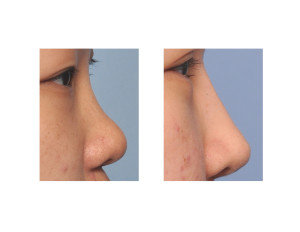Rhinoplasty in the Asian nose is well know to be an augmentation operation, raising the bridge of the nose and increasing tip projection. Together these changes fundamentally increase nasal length which is measured as the distance from the nasion to the tip-defining point. Besides nasal length, other measurements used to define the short nose including a short nasal tip projection and more open nasofrontal and nasolabial angles.
The short nose of Asians can be either due to natural development or induced by a prior rhinoplasty. Unlike Caucasians where a short nose after rhinoplasty is the result of aggressive removal of supporting cartilage structures, in Asians it is due to the addition of implants or grafts for augmentation. If the implant gets infected and has to be removed, scar contracture will cause the tip to rotate upward as well as lower the dorsum due to the implant removal. This accentuates the natural short nose deformity. In some cases with cartilage grafting the tip has been aggressively augmented but the tip is not rotated downward, accentuating the short nose look.
Whether it is due to natural shortness or from the effects of previous rhinoplasty efforts, the correction of the short nose in Asians is challenging. Thick skin and weak lower lateral and septal cartilages make lengthening the nose in the right direction (out and down) difficult. Combined with the frequent need for raising the bridge of the nose as well, it adds to the challenge of aesthetically increasing nasal length.
In the online September 2013 issue of the JAMA Facial Plastic Surgery, an article entitled ‘Lengthening the Short Nose in Asians – Key Manuevers and Surgical Results’ which describes the success and methods to achieve this rhinoplasty change. In a retrospective study of 36 patients who underwent surgical correction of a short nose deformity, they were analyzed with anthropometric measurements for the effect of nasal lengthening. (in essence evaluating how effective the procedure was) Average follow-up was nearly 30 months. The types of cartilage grafts used for nasal lengthening was septal extension grafts reinforced with spreader grafts, dorsal onlay and tip grafts. While all patients were satisfied with their results, nasal lengthening was measurable more effective when rib grafts were used than when just septal or ear cartilage grafts were used. The best results were obtained with septal extension grafts reinforced with extended spreader grafts and dorsal onlay grafts.

Dr. Barry Eppley
Indianapolis, Indiana


